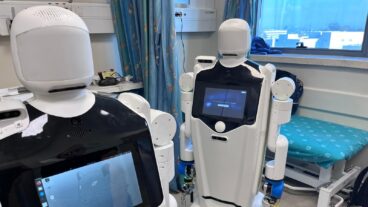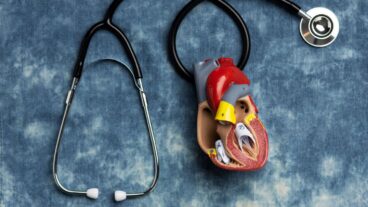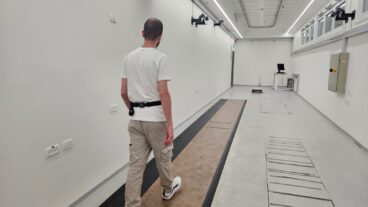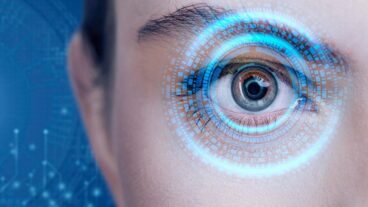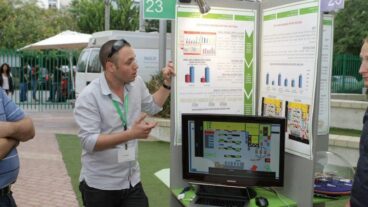Glucon’s non-invasive device measures blood glucose levels in real time.For more than 20 years, the search has been on within the medical and technical community to find a way to make the lives of diabetics easier and less painful, by eliminating an uncomfortable daily ritual – pricking their finger in order to draw a drop of blood to measure their glucose level.
Now, two Israeli companies have developed two different methods to eliminate this unpleasant ritual and monitor glucose levels in a non-invasive, painless manner.
The need to draw blood so frequently not only causes pain and discomfort, but it costs lives. Some diabetics are so put off by the need to do this, that they forgo the testing, that they stop monitoring their blood sugar levels on a regular basis and as a result, their health deteriorates.
As the rate of diabetes continues to climb, this becomes an increasingly urgent problem. At least 140 million people in the world are believed to have diabetes, including 16 million patients in the U.S.
Diabetes is rapidly becoming a major health crisis in the Western world. In the US alone, 16 million people suffer from the condition, a figure that is expected to rise to 24 million by 2010 as the prevalence of diabetes increases. Statistics show that since 2000, one in every three children born in the US will become a diabetic.
There are two types of diabetes. Type 1 diabetics are born without the ability to secrete insulin, and are insulin dependent from the start. Type 2 diabetics develop the condition at some point during their lives. Many can control the problem through diet, but others require insulin.
While the trigger for diabetes is still unknown, researchers suggest that Type 2 diabetes is caused by western lifestyles, particularly obesity, stress, and lack of exercise.
Out of the total diabetic population, about 25-30% are dependent on insulin to control their blood glucose levels. The only real treatment for this segment is to try to keep glucose levels as normal as possible in order to control the condiition, and prevent diabetic complications.
Although no company has yet reached the Holy Grail of finding an non-invasive way of measuring glucose, two of those which have come the closest are Rehovot-based OrSense, and Petah Tikva-based Glucon.
OrSense was founded in late 1996 by Dr. Alex Sternberg and Dr. Ilya Fine, who serves as its chief technology officer. Fine, who immigrated to Israel from the former Soviet Union in the early 1970s, is the mastermind behind the OrSense concept.
OrSense’s proprietary technology, known as Occlusion Spectroscopy – is designed to non-invasively measure multiple and vital blood parameters such as glucose, hemoglobin, cholesterol and others.
The innovative electro-optical technology performs non-invasive blood measurements by means of a finger probe, eliminating the need to draw blood by needle-stick. The company is developing a non-invasive glucose monitor geared for daily use by diabetics who must frequently monitor their blood glucose by means of an
invasive fingerstick test.
“Non-invasive blood monitoring is a field that over the past 20 years, has had many disappointments and only a few successes,” notes Lior D. Ma’ayan, CEO of Orsense, in a conversation with ISRAEL21c. “In all this time, no one was able to bring a non-invasive product to the market; it is extremely difficult technically.”
He says that OrSense stands out from the pack of companies in this area in that it does not try to measure blood in its natural state of circulation. “Our technology is based on creating a new dynamic in the blood – looking at it not in its normal behavior, but abnormal behavior.”
This involves stopping the flow of blood at the index finger by pressuring it gently, and then examining it with an optical probe using sophisticated algorithms.
The market for glucose measurement devices is estimated to be worth $4 billion a year, and investors have enabled OrSense to raise $13 million to date. Included in that amount is a grant of $1.2 million which was awarded by the Office of the Chief Scientist of the Israeli Ministry of Trade and Industry for promising research and development activity.
OrSense, which has 24 employees, has achieved a CE Mark for European approval as a hemoglobin measure. It is now in late stages of clinical trials to get United States Food and Drug Administration approval for parallel marketing in the U.S.
Ma’ayan explains that the business strategy was to first bring a non-invasive product to market for the measurement of hemoglobin, which represents a $500 million dollar business.
Quick and accurate hemoglobin measurement is important in emergency medicine for monitoring the speed of losing blood. And while that product goes on sale, the company will continue with its primary quest – the non-invasive glucose monitor that they hope will play a role in minimizing the damage and the cost of the worldwide diabetes epidemic.
A few minutes away from OrSense’s Rehovot headquarters, another Israeli company has developed a new device that could help diabetics receive an accurate and continuous measurement of their blood sugar levels without having to undergo the unpleasant and time-consuming process of taking blood.
The device, which measures blood glucose levels in real time, was developed by Glucon, a small 15-man start up based in Petah Tikvah. Unlike existing methods on the market, which require diabetic patients to prick their finger between four to seven times a day to test glucose levels, Glucon’s device, which is still in development, can be worn like a watch and provides continuous monitoring at every moment of the day or night.
Glucon was founded in June 2000 by Ron Nagar and Dr. Benny Pesach, experts in the laser and optics sectors. The initial $600,000 in fund-raising came from InnoMed Ventures, which invested a further $3m. one year later. In January, the company raised a further $13.2m. This round was led by Giza Venture Capital, InnoMed, and Infinity Venture Capital. A new strategic partner from Japan, where some 10 million people suffer from diabetes, also took part. This round is expected to close in the next few months with a further few million dollars in investment.
The Glucon device uses photoacoustic (optical and sound-based) technology which enables direct measurement of glucose levels from within blood vessels. It is designed for both clinical and personal use and gives the user an accurate reading of blood glucose levels in real time. It can also activate an alarm if glucose levels rise or drop to pre-set limits. In the future, the device will be able to connect to computers or PDAs, storing data for several weeks or months. It will also be able to transmit information directly to the doctor’s office via cell-phone, or through the computer, enabling doctors to keep log books of all the patients under their control.
At present, the patent-pending device is still at prototype phase, and is larger and more cumbersome than the completed version will be. Eventually, the device will be miniaturized with all of the features including batteries, and electronics, stored inside. The device will be worn on the lower or upper arm.
Like most diabetic solutions on the market today, Glucon plans to supply the main watch-like device to patients for a relatively small sum, and charge them instead for the disposable patches worn with it. These must be replaced every time the device is removed from its location – if a user takes a shower for instance. These patches will cost about 50 cents each, a price that matches similar user strips diabetics buy today. The annual cost is about $1,000. Nagar, who is Glucon’s CEO, hopes that most of this cost will be reimbursed by insurance companies.
Preclinical trials are now underway, and clinical trials are due to start in the US, Europe and Israel, at the beginning of 2005. About 200 people will take part in the trials, which are expected to last two to three months.
The company’s goal is to create a larger version of the device first and push this for FDA approval in 2006. Once approval has been received, the company will also apply for FDA approval for its second, miniature device. Sales of both devices will begin first in Europe by the end of 2006, and then in the US in 2007.
Pesach, the company’s vice president of R&D, believes that Glucon’s device will prove extremely popular. “Taking blood is unpleasant, inconvenient and calls for discipline,” he says. “You have to comply with all the requirements, and not everyone does. Of the diabetic patients coming to our office, only 30-40 percent of the patients take blood glucose measurements, and of those 40% do not do it as much as they should.”
Pesach also believes that the current ‘snap judgement’ finger stick measurement is inaccurate and problematic. “You don’t know if there’s been an error in measurement or not,” he says. “Perhaps you took the measurement inaccurately, or didn’t take enough blood, or were doing it in a hurry.”
Current methods are also problematic for children who must be woken in the night for checks, to ensure they do not suffer long-term complications.
Awareness of the problems associated with current glucose checks, has led many giant pharmaceutical companies to start looking for alternatives. Roche, one of the world’s leading healthcare companies; $7.6 billion Medtronic; and Therasense have all developed products that offer semi invasive continuous monitoring of blood glucose systems. Some have been approved by the FDA for limited use, some, like TheraSense, are in the midst of the FDA approval process, and some are still in development.
According to Pesach, these devices provide the user with continuous measurement of the Intersticial fluid (ISF). The devices take a small sample of this fluid and give a display of the glucose level in the blood. Nagar points out, however, that there is a delay of 10-30 minutes between changes in the glucose level of the ISF and the glucose level of the blood. This time-lag may not sound much, but it is enough to cause problems for a patient, especially if blood glucose levels suddenly drop and the patient goes into a hypoglycemic state and loses consciousness.
The ISF is also affected by many other factors including humidity, heat and cold. “The advantage of our technology is that we can remove the influence of the other layers of the skin and measure the optical properties of the blood directly,” says Pesach.
Another advantage is that because Glucon’s tool measures blood glucose levels it will be viable for reimbursement because it is perceived as a primary tool. Many of the ISF measurement tools are considered adjunctory, rather than primary, because they do not measure blood glucose levels.
Other companies, like California enterprise DexCom, which raised $30m., in 2002, are also working on implantable solutions. While these have many attractive features for patients, they also have disadvantages. For a start they require surgery, and while it is a small procedure, it is still surgery. In addition, Nagar believes it will take these companies much longer to acquire FDA approval, because there are a great many safety issues to resolve in inserting a foreign body into human tissue.
Nagar believes that Glucon, which is now in discussions with potential strategic partners, is the only company today that is developing a measurement system for blood glucose.
At present, Glucon is happy to continue working alone. In future though, there’s a very real chance that the company will be acquired. Nagar admits that TheraSense, which was recently acquired by Abbott Laboratories, a $17.7 billion company that employs more than 70,000 people around the world, is a role model for the Glucon team. The company, which has developed a blood glucose measurement stick that can be used anywhere on the body, built itself up alone, and in November 2001 held a successful IPO on Nasdaq, raising $100m. on a market cap of $800m. Company sales stood at about $250m. a year, when Abbott finally acquired the company in January.
Already, Glucon has been in talks with some of the leading players in this field, and Nagar admits that acquisitions are frequent in this sector. “The big companies are not letting themselves miss a possible solution to the problem when they see a company producing significant results,” he says. “The market is desperate for an alternative. Eventually we will be acquired by a big company no matter whether we choose to go it alone now or not.”




